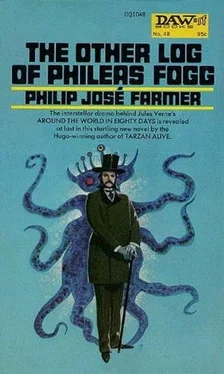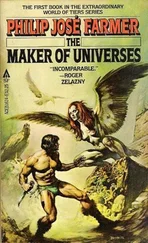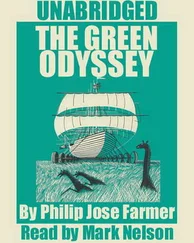Philip Farmer - The Other Log of Phileas Fogg
Здесь есть возможность читать онлайн «Philip Farmer - The Other Log of Phileas Fogg» весь текст электронной книги совершенно бесплатно (целиком полную версию без сокращений). В некоторых случаях можно слушать аудио, скачать через торрент в формате fb2 и присутствует краткое содержание. Жанр: Фантастика и фэнтези, на английском языке. Описание произведения, (предисловие) а так же отзывы посетителей доступны на портале библиотеки ЛибКат.
- Название:The Other Log of Phileas Fogg
- Автор:
- Жанр:
- Год:неизвестен
- ISBN:нет данных
- Рейтинг книги:3 / 5. Голосов: 1
-
Избранное:Добавить в избранное
- Отзывы:
-
Ваша оценка:
- 60
- 1
- 2
- 3
- 4
- 5
The Other Log of Phileas Fogg: краткое содержание, описание и аннотация
Предлагаем к чтению аннотацию, описание, краткое содержание или предисловие (зависит от того, что написал сам автор книги «The Other Log of Phileas Fogg»). Если вы не нашли необходимую информацию о книге — напишите в комментариях, мы постараемся отыскать её.
The Other Log of Phileas Fogg — читать онлайн бесплатно полную книгу (весь текст) целиком
Ниже представлен текст книги, разбитый по страницам. Система сохранения места последней прочитанной страницы, позволяет с удобством читать онлайн бесплатно книгу «The Other Log of Phileas Fogg», без необходимости каждый раз заново искать на чём Вы остановились. Поставьте закладку, и сможете в любой момент перейти на страницу, на которой закончили чтение.
Интервал:
Закладка:
“A suttee is a voluntary human sacrifice. The woman you’ve just seen will be burned at dawn tomorrow.”
“Oh, the scoundrels!” Passepartout cried.
“And the corpse?” Mr. Fogg asked.
“It is that of her husband, an independent rajah of Bundelcund.”
Fogg said, emotionlessly, “Is it possible that these barbarous customs still exist in India? Why haven’t we put a stop to them?”
“They have been terminated in most of India. But we have no power in the savage areas and especially in Bundelcund. The whole district north of the Vindhyas is the theater of unceasing murders and pillage.”
“The miserable woman!” Passepartout said. “Burned alive!”
Sir Francis explained that if a widow somehow got out of the sacrifice, she would be treated with utmost contempt by her relatives, indeed, by all who knew of her refusal to become ashes with her husband. She would have to shave her head and exist on the scantiest of food. She would be less than a pariah, because even a pariah had his own kind to associate with. Eventually, she would die of shame and heartbreak.
Sir Francis did not know that this was not exactly the case with this poor woman. If she could have escaped from Bundelcund, she would have gone to live with her relatives in far-off Bombay. These were Parsis who did not hold with suttee. This sect, descended from Persian fire worshippers whose prophet was Zoroaster, had customs as different from the Hindus as those of the Orthodox Jews from their Gentile neighbors.
The Parsi did not agree with Sir Francis.
“The sacrifice is not willing,” he said.
“How do you know that?”
“Everybody knows about this affair in Bundelcund.”
This statement is another of the many puzzlers in Around The World in Eighty Days. The Parsi lived only thirty miles from the borders of Bundelcund. Yet, what with the mountains, the jungle, and the isolation of his small village, he might as well have lived three hundred miles away. The Bundelcundians were hostile to his people and were not likely to exchange news with him through the so-called grapevine, even if it existed. And how would he know that the rajah had died? He had spoken to no one except the three Europeans since the journey started, and the rajah had died only the night before. Yet Verne says he knew all about it.
The truth seems to be that none of the travelers could possibly have known about the situation if Verne’s story were as he reported it. Fogg and Passepartout knew, of course, that the rajah was dead. But they could not say so, and Verne was unaware of what had really happened that night.
However, the Parsi did say that the rajah’s widow was drugged with fumes of hemp and opium. This would have indicated to him that she had been put into a state wherein she would not disgrace herself or the community by resisting.
This is what happened. Verne, like every good novelist, had inserted some remarks of a purely fictional character to inform the reader swiftly about what was going on.
Still, would the impulse to save the woman from this horrible rite have been strong enough for Fogg to act on it? Why should he have endangered his all-important mission and the wager to attempt a seemingly hopeless rescue? Was it just humanity that caused him to interfere? Perhaps it was. Perhaps there was also the fact, unrecorded by anyone, that Fogg fell in love at first sight with the beautiful woman. But the log reveals that there was another, and no doubt stronger, motive. An Eridanean had been planted in the heart of the rajah’s palace. This was the one who had slipped out a description of the domed room in which the rajah kept his distorter. She, for this Eridanean was female, had gotten as close to the rajah as it was possible for anyone to get. Her beauty and charm enabled her to attract the rajah’s attention easily, and from this to marriage was another easy step.
Fogg had been told all this a long time ago by Stuart via a whist game. This is why, just as the journey was about to be resumed, Fogg said, “Suppose we save this woman?”
Sir Francis exclaimed, “What, save this woman, Mr. Fogg?”
“I have twelve hours to spare. I can devote them to this.”
“Why,” Sir Francis said, “you are a man of heart!”
“Sometimes, when I have the time,” Fogg replied.
Sir Francis must have wondered about this man whose emotions could apparently be turned on or off as if they ran through a spigot. What he did not know, of course, was that Fogg could not decide whether or not he would have a certain emotion or not. The emotion came, willy-nilly, but he could shunt it aside, store it in neural circuit where the emotional charge ran around and around the track, like a current in today’s superconductive circuit. But he could not kill the emotion, because it would not die. Sooner or later, he had to pay for the storage, and he would pay double or treble the bill by the time he released it.
The two other Europeans were all for this idea. But what about the Parsi guide? He could not be expected to risk his life, but he might agree to stay behind and wait for them. Even this would be dangerous for him.
He answered that he was a Parsi and that the woman was a Parsi. He was in this with them all the way.
Verne says that the Parsi knew all about her. Probably, Verne got this from Fogg’s public log and inserted the informational conversation about her in the Parsi’s mouth for the benefit of the reader. In any event, we know that she was a famous beauty, the daughter of a wealthy merchant of Bombay. If she were that famous, then the Parsi may have heard about her after all. Travelers coming through his remote village may have gossiped about her.
The woman’s name was Aouda Jejeebhoy, and she had been educated in an English school in Bombay. This, plus her light skin, enabled her to pass as a European. She was related to the wealthy Parsi who had been created a baronet by the queen. He was Sir Jametsee Jejeebhoy, whom the curious reader may find listed, with some biographical details, in Burke’s Peerage.
The Parsi said that after her parents had died, she had been forced to marry the rajah.
(This, of course, was what the rajah and the public believed. She had succeeded in making it look as if she were a victim. If she had been eager to marry him, she would have aroused his suspicions.)
The Parsi, however, was right in saying that she had fled as soon as the rajah died but had been captured and returned to the capital city. The rajah’s relatives were insistent that she perform the suttee, since they did not wish her to inherit the rajah’s wealth.
This was probably true, Fogg thought. If Nemo had found out, or even suspected, that she was an Eridanean, he would have saved her from the suttee. She would be too valuable as a source of information for him to allow her to be wasted on the funeral pyre. But it was possible that Nemo no longer had any influence in Bundelcund and was helpless to prevent her-to him-too-early death.
The Parsi guided the travelers to the temple of Pillaji, where the distressing ceremony was to take place. Thirty minutes later, they were hidden in a dense copse about one hundred and sixty-seven yards from the Brahmin temple. Kiouni made much noise by tearing off branches and eating them, but this could not be helped. The beast was very hungry, and any efforts to stop him might result in his making even more noise. Fortunately, the distance from the crowd, the uproar it was making, and the thick vegetation that surrounded the travelers would keep the Bundelcundians from noticing the sounds the elephant was making.
Fogg questioned the guide about the layout of the area around the temple, its interior design, and the behavior of the Hindus at such occasions. Verne says that the Parsi was familiar with the temple. But why would a Parsi ever have gone into a Hindu temple, especially one in hostile territory? Perhaps, being intelligent, and hence curious, the Parsi had picked up his knowledge by questioning various Hindus of his village, or travelers, who had worshipped there. The Pillaji temple seems to have been a famous one.
Читать дальшеИнтервал:
Закладка:
Похожие книги на «The Other Log of Phileas Fogg»
Представляем Вашему вниманию похожие книги на «The Other Log of Phileas Fogg» списком для выбора. Мы отобрали схожую по названию и смыслу литературу в надежде предоставить читателям больше вариантов отыскать новые, интересные, ещё непрочитанные произведения.
Обсуждение, отзывы о книге «The Other Log of Phileas Fogg» и просто собственные мнения читателей. Оставьте ваши комментарии, напишите, что Вы думаете о произведении, его смысле или главных героях. Укажите что конкретно понравилось, а что нет, и почему Вы так считаете.












